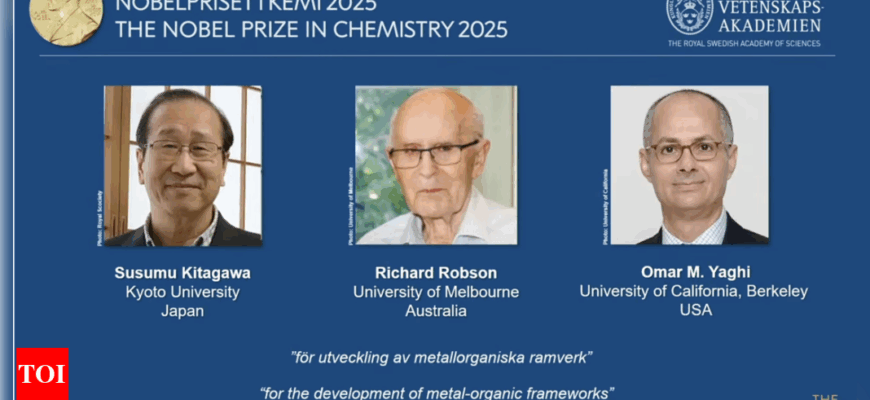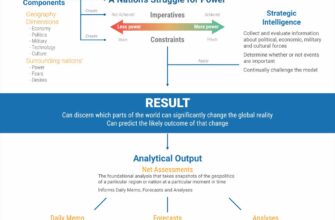Stockholm, October 8, 2025 – The Royal Swedish Academy of Sciences today illuminated the global scientific stage, announcing three distinguished researchers as the recipients of the 2025 Nobel Prize in Chemistry. The prestigious award goes to Japan`s Susumu Kitagawa, the UK`s Richard Robson, and Jordan-born American Omar Yaghi for their groundbreaking work on Metal-Organic Frameworks, or MOFs. This recognition celebrates not just a discovery, but a new era in molecular architecture, offering innovative solutions to some of humanity`s most pressing challenges.
The Invisible Architects: What Exactly Are MOFs?
Imagine building blocks so small they`re invisible, yet so powerful they can capture carbon dioxide from the air or harvest water from a desert. This is the essence of Metal-Organic Frameworks. At their core, MOFs are crystalline, porous materials crafted from metal ions (the “cornerstones”) meticulously linked by organic molecules (the “struts”). The result? Structures that resemble microscopic sponges, riddled with vast internal cavities and an astonishingly high surface area. These sophisticated molecular cages can be engineered with exquisite precision, allowing scientists to design materials capable of trapping, filtering, and transforming substances with unprecedented efficiency.
The Nobel Committee succinctly described their achievement: “They developed a new form of molecular architecture.” This understated phrase belies a revolution, transforming our understanding of material design from bulk properties to atomic-level engineering.
A Trio of Visionaries Spanning Continents
The journey to this groundbreaking discovery is a testament to persistent inquiry across diverse academic landscapes:
- Susumu Kitagawa, a revered professor at Kyoto University in Japan, was instrumental in the early conceptualization and demonstration of these novel porous materials, laying critical groundwork for the field.
- Richard Robson, based at the University of Melbourne in Australia, contributed significantly to the foundational principles of MOF synthesis and understanding, his work forming essential pillars for future development.
- Omar Yaghi, affiliated with the University of California, USA, is often credited with galvanizing the field, pushing the boundaries of MOF complexity and application, and popularizing their immense potential.
Together, their individual insights and collective contributions have forged a new frontier in chemistry, showcasing the power of global scientific collaboration. It’s a pleasing reminder that brilliance knows no national boundaries, only shared curiosity.
From Concept to Consequence: MOFs in Action
The true brilliance of MOFs lies in their versatility and their profound potential to address real-world problems. As Heiner Linke, Chairman of the Nobel Committee for Chemistry, implicitly conveyed, these frameworks “possess enormous potential, opening up previously unforeseen possibilities for custom-made materials with new functions.”
Environmental Salvation and Resource Management
One of the most captivating applications of MOFs is their role in environmental remediation. Picture giant molecular sieves designed to selectively capture carbon dioxide from industrial emissions, or even directly from the atmosphere – a crucial step in combating climate change. For arid regions, MOFs offer a glimmer of hope: their ability to efficiently absorb water vapor, even from the driest desert air, could revolutionize fresh water provision. It`s a bit like having a high-tech, self-filling canteen for the planet, available even when nature seems to have forgotten its hydration duties.
Powering the Future and Catalyzing Innovation
Beyond the environment, MOFs are poised to transform energy storage and industrial processes. Their exceptional porosity makes them ideal candidates for safely storing vast quantities of gases, such as hydrogen for clean fuel cells or methane (natural gas), within a compact volume. In catalysis, MOFs can act as highly efficient reaction chambers, speeding up chemical transformations with greater selectivity and less waste, paving the way for greener and more sustainable manufacturing. The promise here is not just better products, but cleaner ways to make them.
With tens of thousands of unique MOF structures already synthesized, the scope for future applications is astounding. From advanced drug delivery systems that precisely target diseased cells to ultra-sensitive sensors for diagnostics and environmental monitoring, these “molecular Lego” systems are truly limited only by our imagination and, perhaps, the next brilliant insight from a curious mind.
A Glimpse into Tomorrow`s Materials
The 2025 Nobel Prize in Chemistry celebrates not merely a scientific achievement, but a promise – a promise of a future where materials are not just found, but intelligently designed to solve specific challenges. Kitagawa, Robson, and Yaghi have shown us that by understanding and manipulating matter at its most fundamental level, we can indeed build a better, more efficient, and more sustainable world. Their legacy will undoubtedly inspire generations of chemists to continue pushing the boundaries of what is possible, one precisely constructed molecule at a time, proving that sometimes, the smallest structures hold the biggest solutions.








